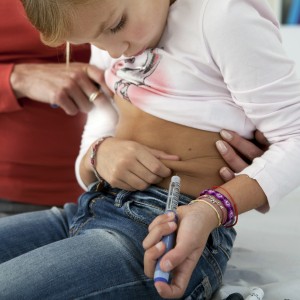 Results from a recent study published in the journal Diabetologia indicate that by measuring the presence of specific antibodies in the blood it may be possible to identify who is going to develop type 1 diabetes.
Results from a recent study published in the journal Diabetologia indicate that by measuring the presence of specific antibodies in the blood it may be possible to identify who is going to develop type 1 diabetes.
In addition to elevated blood glucose, Islet autoantibodies define type 1 diabetes. These autoantibodies are detectable for a variable period of time before diabetes onset.
As a result, the occurrence of islet autoantibodies is related to the beginning of the disease process. The age and order in which autoantibodies appear may be related to different genetic backgrounds and/or environmental exposures.
“In the TEDDY study we have found that autoantibodies often appear during the first few years of life,” said Professor Åke Lernmark from Lund University, study leader in Sweden in a recent news release.
A total of 8,600 children from Sweden, the United States, Germany and Finland took part in the TEDDY study. Infants enrolled had a high genetic risk for type 1 diabetes and were prospectively followed with standardized autoantibody assessments quarterly throughout the first 4 years of life and then semi-annually thereafter. TEDDY stands for “The Environmental Determinants of Diabetes in the Young.”
In the study entitled, “The 6 year incidence of diabetes-associated autoantibodies in genetically at-risk children: the TEDDY study,” the research team found that at 34,091 total person-years of follow-up, autoantibodies appeared in 6.5% of the children. Autoantibodies at 3 and 6 months of age were rare.
Of the 549, 43.7% had islet autoantibodies to insulin (IAA) only, 37.7% had glutamic acid decarboxylase autoantibodies (GADA) only, 13.8% had both GADA and IAA only, 1.6% had insulinoma antigen-2 only, and 3.1% had other combinations.
“If a second autoantibody is detected later, then the person will get diabetes — but it may take up to 20 years,” said Åke Lernmark.
The incidence of IAA only peaked within the first year of life and declined over the following 5 years, but GADA only increased until the second year and remained relatively constant. GADA only was more common than IAA only in HLA-DR3/3 children but less common in HLA-DR4/8 children.
“In TEDDY, 40 per cent of these children had already developed diabetes,” said Dr. Lernmark. “It is possible that there are two different diseases involved. Perhaps one virus triggers the autoantibodies against insulin and another one the autoantibodies against GAD65.”


